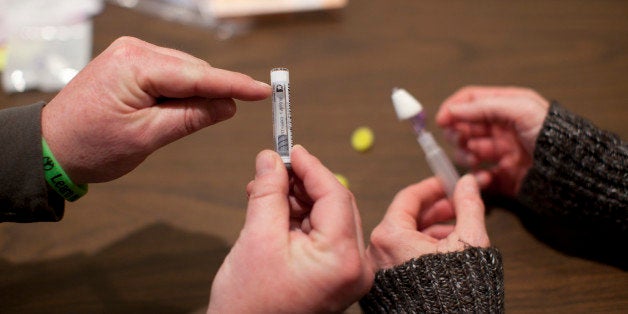
It's been a groundbreaking month in the national dialogue about opiate dependency and addiction. From halls of government to family living rooms, the country is positioning for a dramatic shift in attitudes about drug policy that might finally mean an end to the drug war in favor of a public health and human rights approach.
In early February, a series of bills were introduced in the Maryland state legislature that would decriminalize small amounts of drugs for personal use, expand access to treatment in emergency rooms and hospitals, and allow for consumption rooms where people would be able to use safely under medical supervision.
Polling commissioned by the Drug Policy Alliance of prospective voters in New Hampshire and South Carolina showed a strong majority of bipartisan support in favor of decriminalizing drug use and possession.
Legislation allowing for syringe exchange to reduce HIV risk is making headway in Florida. Meanwhile, an opioid overdose prevention bill sailed through the New Mexico state legislature with unanimous support.
This week, Ithaca, NY made national headlines with the first ever comprehensive municipal plan to address over-incarceration and skyrocketing overdose deaths, while creating a comprehensive health-based approach to drug policy. This plan, championed by the charismatic young Ithaca mayor Svante Myrick, particularly sparked the attention of media because, as in Maryland, it includes safe consumption rooms, an innovation that has been already used with effective results in reducing overdose deaths in parts of Europe and Canada.
Equally noteworthy is the premiere of the PBS Frontline two-hour special "Chasing Heroin," chronicling the stories of several people battling opiate addiction and presenting visionary new approaches such as Law Enforcement Assisted Diversion (LEAD), which gives police the mandate to refer drug users to health services instead of arresting them.
All of these developments reflect an unprecedented momentum and mainstreaming of core concepts of harm reduction, a philosophy that replaces punishment with compassion, health, dignity and scientific reason. As Mikel Kowalcyk, a LEAD outreach coordinator in Seattle, WA explains in "Chasing Heroin," "The harm reduction model is people are going to use drugs. Let's make it safe for them to use drugs until they are ready to do something different."
Harm reduction presents a revolution in drug policy because it emphasizes saving lives and keeping people healthy, whether or not they use drugs. Instead of forcing people to remain unconditionally "drug-free" and locking them up or leaving them to die if they relapse or don't comply, this approach requires empathy, support, meeting people where they're at and looking at them as a whole person and not simply "clean" versus "dirty."
As many have pointed out, including in the Frontline special, this shift in attitudes about opiate drug use and openness to a more compassionate approach is emerging at a time when the face of the addicted heroin user imprinted in the public conscience has become whiter and more middle class. There is an undeniable subtext of racial bias in this reversal from a largely punitive approach when the most impacted communities were seen as people of color living in poverty.
Still, Black, Latino and Native Americans have also experienced a dramatic increase in opiate-related overdose deaths in recent years. While a more enlightened approach to drug policy is more than welcome, it is horrifying to think of how many lives could have been saved, if this had happened sooner.
The main criticism of a harm reduction approach is that it enables drug use. The reality is that it is an exercise in delusion to think that other people's drug use is something we can control. People will use drugs, whether we like it or not. The question is how do we respond - by affirming human life or treating it as something disposable? It is a blunt and brutal reality that our response is hugely influenced by how close we feel to the person using drugs or whether we can dismiss them as the "other."
Last fall, I had an incredible opportunity to visit a harm reduction center in Copenhagen, Denmark with multiple safe consumption rooms on site, along with assorted health services, supportive housing, counseling, a café and even a kindly nun who comes in to tend to the feet of drug users, making sure they are protected and free from infection.
The staff showed such glowing pride in their work that I could not help but feel inspired. They all emphasized how many of the users came from lives of trauma, pain and psychological problems.
As one of them explained, "It's not simply about drugs and whether someone is using or not. It's about looking at the whole person and doing everything you can to help keep them well."
Sharda Sekaran the managing director of communications for the Drug Policy Alliance.
This piece first appeared on the Drug Policy Alliance Bloghttp://www.drugpolicy.org/blog/harm-reduction-drug-policies-gaining-momentum-across-country